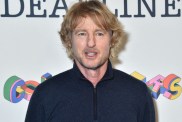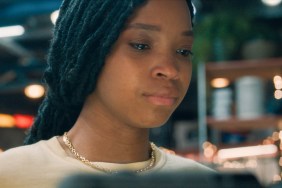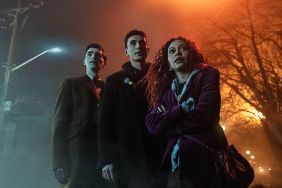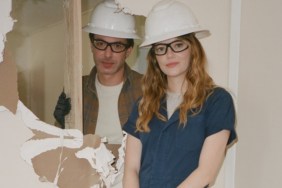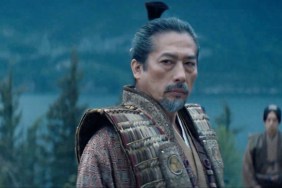
Getting to the animation, how did you come up with the idea for the “skin” on the emotions, which appears to be more fluff than skin.
PD: That grew out of this notion that we wanted the characters to look the way our emotions feel to us. I didn’t want them to be fabric or skin or something. That launched a large, exploratory effort with our art and technical teams. At first we were playing with this vaporous [idea] and they looked a little too much like ghosts. So the way it ended up we modeled them normally, but instead of the surface, they filled it with fog and then mixed in with that are these frontwards-facing discs that have got just a little bit of movement to them. So, no matter where you’re looking, those discs orient to camera. It ends up feeling like atoms or movement of energy, which, to me, really accomplishes the idea.
JR: I think it was Ralph Eggleston, our production designer, or you, but “energy” felt like something of a key word and a believable building material. Even the walls in Headquarters and tables would be like this compression of energy.

Then I was reading about the work Tony Fucile did on the project, serving as an animation sketch artist and bringing hand-drawn animation to the film. The industry has obviously gone away from hand-drawn, so how do you see the marriage of those two and what are the limitations of one versus the other that, in this case keeps hand-drawn animation alive even if the audience might not know it.
PD: As we came up with this idea I began thinking about how caricature, like if you look at Al Hirschfeld or any of these caricature artists, if they’re really good they can sometimes make a person look more like them than a photograph because they’re distilling out anything nonessential to that likeness., they’re focusing in on the big nose or whatever it is. Movement, I think, can do that as well and animation can really embody that.
[We at Pixar], from our history, approached things almost scientifically. Of course we all came from hand-drawn, but I think on Toy Story, just for example, as we were building Buzz’s face or some of the humans, we looked at musculature, human musculature, just to understand how the sub-orbital and the smile muscle connects here, and pulls that way, etc. So we were thinking pretty realistically. On this film, because it was about emotions, we thought, “Man, we can throw the ball the other way. We can go look at all the great stuff we grew up on — Tex Avery and Chuck Jones.” So, Tony is such a great artist, he has an instinctive sense, sometimes when you’re drawing I don’t think you can fully explain why you’re doing something, it just kind of comes out of the pencil, and only later can you say, “Of course, I’m breaking the elbow in a way that it couldn’t just to emphasize the stretch or the intention of the pose.”
So he would draw over almost every scene, breaking down key poses and push things further, especially in the emotions.
JR: Yeah, we have a Cintiq that you can draw on as the shot is looping and people can pause it on a frame and start talking and Tony would start drawing over it. You can just see it —
PD: –getting stronger, yeah.
So that obviously influences the CG animation.
PD: Yeah, so the animators then take those drawings back to their desk and even though it wouldn’t instinctively occur to them to dislocate the shoulder, they can do that just to get the necessary stretch, to really exaggerate things.
So would this movie work as a 2D, hand-drawn animated feature?
PD: Yeah, I think it could.
So why have we lost that? Is it a matter of audiences are just used to the new thing now and they wouldn’t show up to watch a hand-drawn feature?
JR: Character animation-wise, the movie would work beautifully in 2D, but one of the things I like is we’ve got these dimensional screens and memories in space that I really think benefit from CG. Having applied space, I love having that screen and that shot-within-a-shot. I think in 2D that might not be as lush.
PD: Yeah, that’s true, but the idea would still be there and there would probably be other advantages to 2D that we didn’t even get in 3D, but you’re right there is a dimensionality, a lushness and textural things that you don’t get in 2D.

Then, last year you had The Blue Umbrella, which was photo-realistic animation, do you see that becoming a “thing” or is that something that should largely be reserved for inanimate objects? Basically, are you defeating the purpose of animation by doing photo-realistic animation?
PD: I think it really depends on what the story asks for. For example, with Inside Out, since it’s a made up space and we’re talking about emotions and feelings, we really wanted to exaggerate in caricature. Outside, we needed to make this feel like it was more or less believable and realistic, so it’s pushed that way, obviously it’s not photo-real, the characters are pretty cartoon still. But, relative to each other, there are story reasons that might ask for a treatment to be pushed a certain way or another.
I’m more interested in caricature. I think most of the stuff we do leans that way.
It’s there a large sense of pressure working at Pixar? Number one, you look at a DVD or Blu-ray and there aren’t a ton of deleted scenes and you look at a movie like Toy Story 3 that is said to have been made for $250 million, which just goes to show how expensive every second of footage actually is, nothing an be left on the cutting room floor. So you don’t really have the ability to cut something as easily as you would with a live action feature considering how thought out every thing is in advance.
PD: That’s true.
JR: It’s a lot of pressure. The movies are big, they take a long time, this is the fifteenth one and they’ve all been received pretty warmly. There’s not a ton of pressure from the studio other than “make it great”, we show Disney, we have screenings —
PD: There’s pressure when it’s not working out. [laughing]
JR: And that’s to be expected when you’re doing this job.
PD: The other nice thing, to go backwards on what I just said, it’s expected that it’s not going to work for quite a while. Whereas, I think if you’re showing this at a lot of studios in Hollywood, and you’re putting yourself out there, there’d be a lot of scrutiny, a lot of nervousness, because people may or may not understand the process by which you make things. With us everybody knows we’ve made 15 of these now, our executive is a guy who’s making his own film over there, so everybody kind of knows it’s going to suck for a while.
So I’m assuming as you’re screening it it’s in various forms of doneness, or not at all finished.
JR: Right, we screen it in various stages. The first screening is all storyboards and temporary voices. Each screening, maybe every three or four months, there’s a little more done. It probably takes about three or four screenings before there’s even built to be laid out. So every time you see it you’re seeing less storyboards and more animation, so obviously the deeper you get the higher stakes the notes get. We always, with every screening, try and scale down the notes. Screening one or two you know you’re going to hear like, “I don’t understand this” or “Who’s the main character?” or “I don’t like her”. Then screening four or five you’re hoping you hear “That gag should be funnier” or “That shot feels too long”.
PD: Jonas has this great diagram idea that the movies starts from a single point of origin, in this case that was me, and then it expands outward with more and more potential and ideas, and you’re getting wider and wider and at some point Jonas says his job is to make sure we bring it back to end at a single point.

